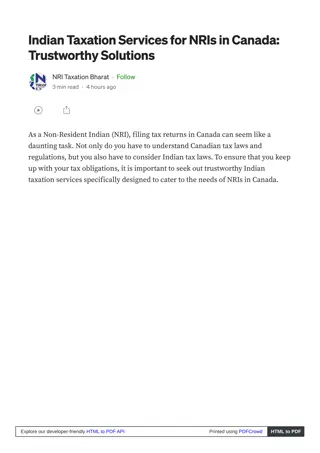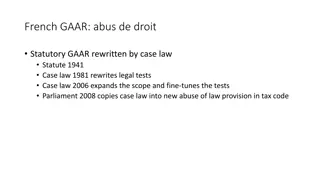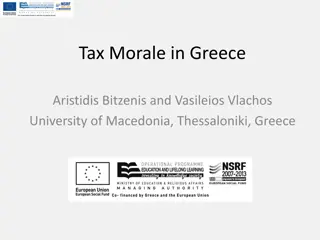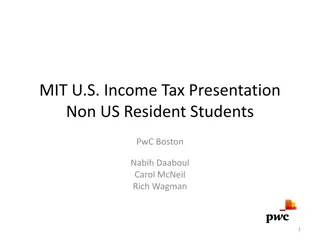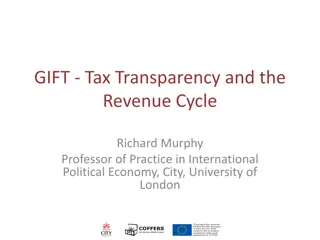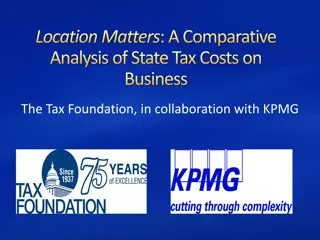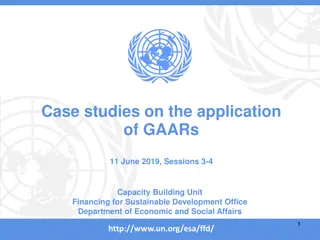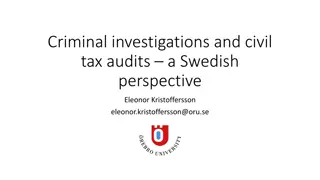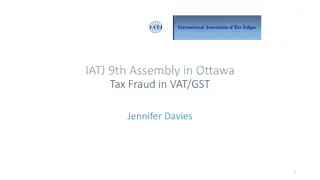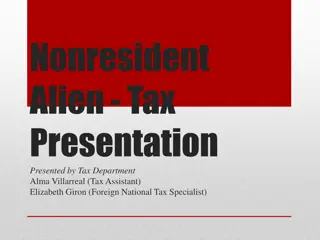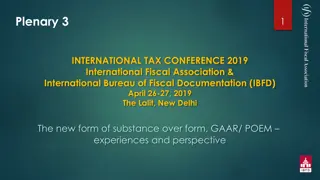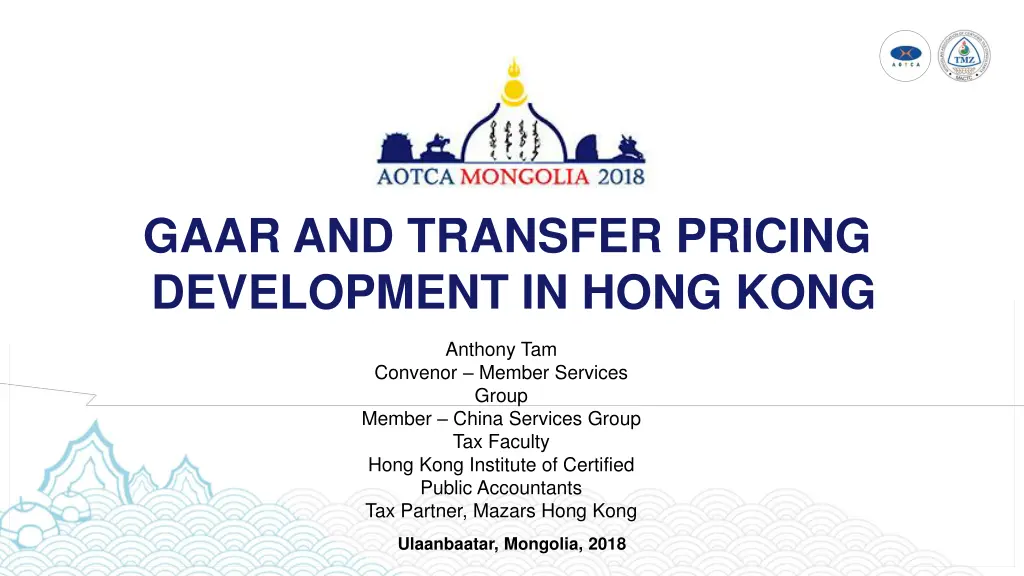
Transfer Pricing Rules and GAAR in Hong Kong
Learn about the main types of anti-avoidance rules in international tax planning, including transfer pricing rules and the General Anti-avoidance Rules (GAAR) used in Hong Kong. Explore concepts like the Arm's Length Principle and OECD Guidelines for intercompany transactions.
Download Presentation

Please find below an Image/Link to download the presentation.
The content on the website is provided AS IS for your information and personal use only. It may not be sold, licensed, or shared on other websites without obtaining consent from the author. If you encounter any issues during the download, it is possible that the publisher has removed the file from their server.
You are allowed to download the files provided on this website for personal or commercial use, subject to the condition that they are used lawfully. All files are the property of their respective owners.
The content on the website is provided AS IS for your information and personal use only. It may not be sold, licensed, or shared on other websites without obtaining consent from the author.
E N D
Presentation Transcript
GAAR AND TRANSFER PRICING DEVELOPMENT IN HONG KONG Anthony Tam Convenor Member Services Group Member China Services Group Tax Faculty Hong Kong Institute of Certified Public Accountants Tax Partner, Mazars Hong Kong Ulaanbaatar, Mongolia, 2018
MAIN TYPES OF ANTI-AVOIDANCE RULES AGAINST INTERNATIONAL TAX PLANNING Transfer Pricing Rules Thin Capitalization Rules and Rules Limiting Interest Deductibility Controlled Foreign Company (CFC) Rules General Anti-avoidance Rules (GAAR) Use of Withholding Taxes On interest, dividends On royalties On service payments For Hong Kong, the only tools used are GAAR and Transfer Pricing Rules 01
TRANSFER PRICING RULES Arm s Length Principle TP Documentation - CbC Reporting - Master File - Local File 02
ARMS LENGTH PRINCIPLE Definition from Article 9 of the OECD Model Tax Convention: [Where] conditions are made or imposed between two [associated] enterprises in their commercial or financial relations which differ from those which would be made between independent enterprises, then any profits which would, but for those conditions, have not so accrued, may be included in the profits of that enterprise and taxed accordingly. 03
OECD GUIDELINES Intercompany prices should reflect functions performed, risk assumed, and assets utilized by relevant entities involved in an intercompany transaction Functions o Activities performed by each of the entities engaged in a particular transaction o R&D, procurement of supplies and materials, manufacturing, sales & distribution, marketing, etc. Risks o A portion of the rate of return earned by any company reflects the fact that the business is bearing risks of various kinds o Market risk, inventory risk, credit risk, forex risk Assets o Only valuable non-routine intangible assets (i.e. super intangibles) matter from a TP perspective 04
OECD GUIDELINES (CONTD) Characteristics of the property, intangible or services to be transferred Contractual terms / Delineation of Transactions Markets Geographic and Level (i.e. distributor vs. retail) Business strategy Availability of data DEMPE Functions 05
EXAMPLE ON DELINEATION OF FUNCTIONS Construction Parent Company Country A Administrative support Country B Expertise Company Project Company Country C Principal Supporting charges (Significant losses) Long-term project Country A s + Country C s tax rate > Country B s tax rate 06
GENERAL ANTI-AVOIDANCE RULES (GAARs) Major Features of a GAAR 1. Definition of a transaction or services of transactions 2. Definition of a tax benefit 3. Purpose Test 4. Exception or relieving provision 5. The role of economic substance 6. Determination of tax consequences 7. Relationship between GAAR and Tax Treaties 07
COMMON CHARACTERISTICS GENERALLY FOUND IN GAARs AMONG COUNTRIES 1. Identification of a scheme or arrangement; 2. Quantification of tax benefit or tax advantage associated with the scheme; 3. Purpose test to assess if the firm achieves a tax advantage through the scheme; 4. Differences in GAAR, e.g. inclusion of misuse or abuse provision, tainted element provision 08
GAAR IN HONG KONG 1. Section 61 Artificial or fictitious transactions Remedy is to ignore the transactions 2. Section 61A Applied to transactions that are carried out for the sole or dominant purpose of obtaining tax benefits 7 factors test The IRD could substitute the transaction by a reasonable postulated hypothetical transaction 3. Specific Anti-avoidance Rule E.g. Section 9A attacking scheme to avoid salaries tax by using service company 09
CIR v. Tai Hing Cotton Mill (Development) Limited Tai Hing Payment: Fixed fee of $746 mil + 50% residual profit = $1,084 mil total Unrelated developer Land Taxpayer Construction Land development JV Court ruled sole or dominant purpose test satisfied Parties not dealing at arm s length Purpose was to mop up as large a portion of the taxpayer s profits as seemed decent in the circumstances and transfer them tax free to Tai Hing Not necessary to look further than its terms and the relationship between the parties Remedy use arm s length sale price of $800 million to assess tax to Tai Hing 10
Ngai Lik Electronics Co. Ltd. v. Commissioner Parts SWL Finished goods Taxpayer Mfg/Parts DWE Marketing and sales Mfg/ FG R&D Parts NWP Procurement & Support services Mfg/Parts Was tax avoidance the sole or dominant purpose? - Factors considered: Master agreement establishing prices based on competing suppliers prices was superseded by annual price-fixing arrangement o Transactions recorded in quantities ordered/delivered only o FG prices set at year end Assessable profits fell after the implementation of annual price-fixing arrangement Remedy Remitted to BoR / Commissioner to determine arm s length transfer prices between DWE and Taxpayer 11
CURRENT TRANSFER PRICING RULES IN HONG KONG Passed in July 2018 Adopts BEPS Action Plan 13 in TP Documentations Endorsed Arm s Length Principle Deeming Provision on Income From Intellectual Property (IP) DEMPE Function 12
Thank you 13


